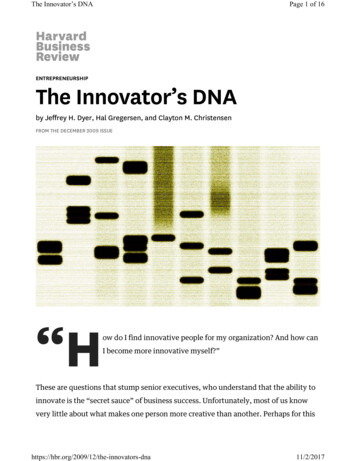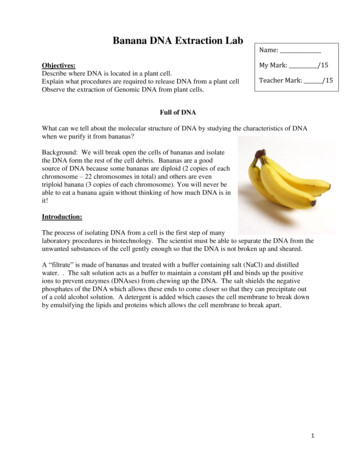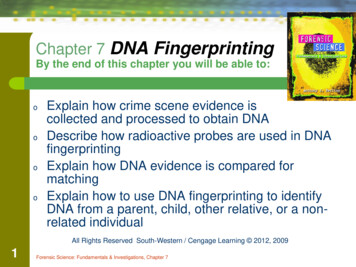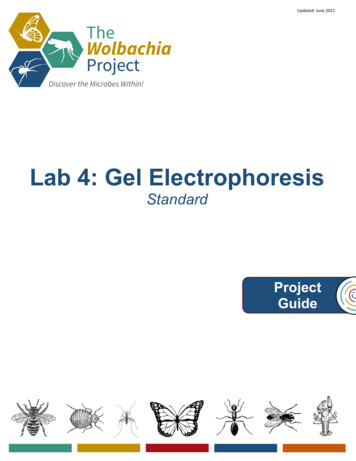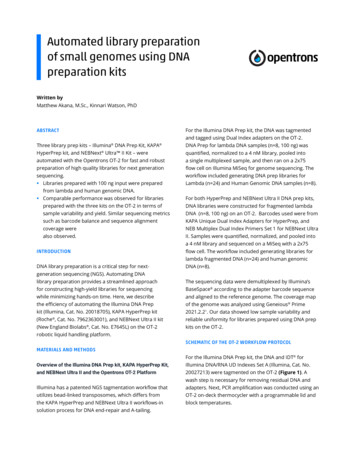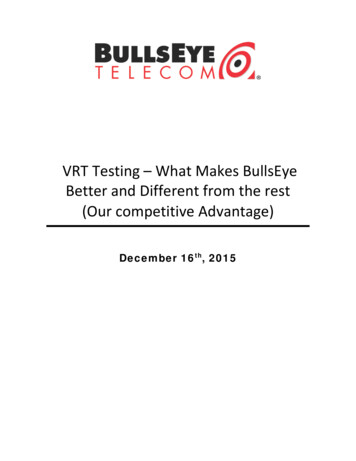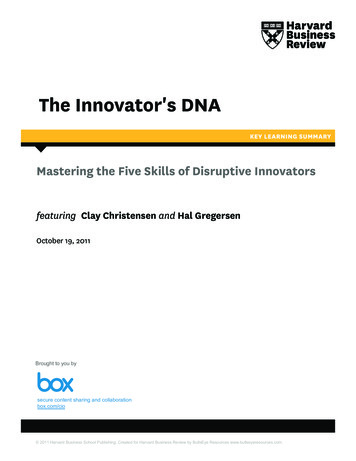
Transcription
The Innovator's DNAKEY LEARNING SUMMARYMastering the Five Skills of Disruptive Innovatorsfeaturing Clay Christensen and Hal GregersenOctober 19, 2011Brought to you bysecure content sharing and collaborationbox.com/cio 2011 Harvard Business School Publishing. Created for Harvard Business Review by BullsEye Resources www.bullseyeresources.com.
The Innovator's DNA:Mastering the Five Skills of Disruptive InnovatorsOctober 19, 2011The Innovator's DNA: Mastering the Five Skillsof Disruptive InnovatorsClay Christensen, Professor of Business Administration, Harvard Business SchoolHal Gregersen, Senior Affiliate Professor of Leadership, INSEADSarah Cliffe (Moderator), Executive Editor, Harvard Business ReviewOVERVIEWWhile the majority of people see creativity as being related toa person’s genetics, this isn’t true. What makes people greatinnovators is not their genetic makeup, but a set of skills andbehaviors. The good news: anyone can learn, practice, andmaster the skills necessary to become a disruptive innovator.The key skill is developing associative thinking, which is theability to connect previously unconnected ideas. Actions thatcan enable new types of connections include questioning,observing, networking, and experimenting. By being moreattuned to these behaviors, by allocating time to them, and bypracticing them, they can be mastered. Mastery results in theconstant production of innovative new ideas.CONTEXTProfessors Christensen and Gregersen shared insights fromtheir new book, The Innovator’s DNA: Mastering the FiveSkills of Disruptive Innovators. They described the researchthat underpinned the book, explained the five skills, andprovided examples of how to use these skills.KEY LEARNINGSDiscovering the “Innovator’s DNA” came from researchamong great innovators.Clay Christensen’s work on innovation has looked at patternsof innovation in industries and companies. But he realizedthat he wanted to learn more about how individuals come upwith innovative ideas and make innovations happen.The goal: understand the skills that innovators use to producenew products, services, processes, and business.Being able to innovate is not a genetic capability; it can belearned, practiced, and mastered.About 75% of people believe that the following is a truestatement: “Studies by psychologists show that creativity islargely a genetic endowment.” By agreeing with thisstatement, people essentially are saying that they thinkcreativity and innovation are the providence of a select few.But that statement is actually false. Research among identicaltwins (who obviously have the same genetics) who wereraised apart in different environments shows that geneticsonly accounts for 30% to 35% of a person’s creativity. Abouttwo-thirds of a person’s ability to generate ideas is based ontheir experiences and the skills developed during their life.The conclusion: People are not “born innovators.” Innovatorshave certain skills that are developed.Disruptive innovators have mastered five essential skills.Innovators see problems and transform these problems intosolutions. That is what great innovators like Steve Jobs(Apple) and Jeff Bezos (Amazon) have done. And in turningproblems into solutions, they think differently. The questionsare, “How do innovators think differently? And how do theyact differently?”Through their research, the speakers have identified fiveskills and behaviors that yield innovative results—and thatcomprise “the Innovator’s DNA.” They are:So, along with Hal Gregersen and Jeff Dyer, Christensenidentified the 100 most innovative companies in the worldand interviewed their founders and current CEOs. They thenconducted surveys among 5,500 innovators and managers. 2011 Harvard Business School Publishing. Created for Harvard Business Review by BullsEye Resources www.bullseyeresources.com.www.hbr.org1
The Innovator's DNA:Mastering the Five Skills of Disruptive InnovatorsOctober 19, 2011AssociatingAssociational thinking means associating or connectingthings that were not previously connected.“Creativity is connecting things."—Hal Gregersen, quoting Steve JobsTwo examples:1. The iPod. While working to simplify the design of theiPod, a designer was playing with the spin dial of acombination lock. He saw the spin dial as a way to makethe iPod’s interface simple and user friendly. Creativitycame by connecting two unrelated things.When former Procter & Gamble CEO A.G. Lafley visited acountry, he went into retail stores asking a barrage ofquestions, and then went into consumers’ homes asking morequestions. He wanted to know how people used P&G’sproducts and whether they were delighted.Likewise, innovator David Neeleman is known for askingquestion after question. Neeleman founded JetBlue, whichinnovated with paperless ticketing and televisions on thebacks of seats. In his newest venture, Azul airlines in Brazil,Neeleman learned by asking questions that a barrier tocustomers flying was the difficultly and expense to get to theairport. So, based on learning from the questions it asked,Azul innovated by starting its own bus service to get people tothe airport.Professor Gregersen suggested that groups trying to generatenew ideas take just 15 minutes to ask every possible questionthey can think of about a problem or possible solution. (Hetermed this process “Questionstorming.”) Just the process ofquestioning will unlock multiple ideas and opportunities.2. Salesforce.com. While on a sabbatical, Oracle executiveMarc Benioff thought about how Amazon.com wasproviding various cloud-based technology services forsmall businesses. He connected this thought with hisexpertise in enterprise software to develop Salesforce.com,which is cloud-based enterprise software for smallenterprises.While children are naturally good at associative thinking,adults are not. But it is possible for adults to engage inassociative thinking by forcing and by feeding. One way is tomake associating a discipline, to be conscious of it, and toallocate time for it. For example, there is an idea-generatorapp that presents three seemingly unrelated words. Ideas aregenerated by looking for connections.The other four innovation skills all are behavioral, and helpindividuals make connections of unrelated ideas.QuestioningA skill of innovators is to constantly ask questions such asWhat if? Why not? What is keeping us from ? What are thebarriers to ?“The important and difficult job is never to findthe right answers; it is to find the right question."—Hal Gregersen, quoting Peter DruckerObservingAnother way to trigger new type of connections is to get outinto the world and observe things. Combining observing andquestioning can yield great new ideas.For example, Scott Cook observed his wife’s frustrations asshe paid the family’s bills and balanced her checkbook. Cook,who also had been exposed to early generations of Applesoftware, connected these two unconnected things andconcluded that simple dropdown software could be used tohelp consumers manage their checkbooks and help smallbusiness owners do their bookkeeping. From these insightsCook founded Intuit, which makes Quicken software forconsumers and QuickBooks for small businesses.Another example: Dollar General Stores observed that manycustomers came into the store on Tuesday mornings andwalked through the store somewhat aimlessly, withoutspecific items on their shopping list. Confused by this 2011 Harvard Business School Publishing. Created for Harvard Business Review by BullsEye Resources www.bullseyeresources.com.www.hbr.org2
The Innovator's DNA:Mastering the Five Skills of Disruptive InnovatorsOctober 19, 2011observation, researchers asked these customers, “What areyou doing? Why are you here?”result in thinking differently, which will result in innovativenew ideas.Their answer was that trucks arrived on Mondays withoverstocked items. As a result, on Tuesdays, the aisles werefilled with an unpredictable selection of items. making theshopping experience like a treasure hunt. Shoppers came onTuesday mornings because they learned about DollarsGeneral’s arrival schedule and loved the treasure huntexperience, an insight only gleaned through observation andquestioning.“If you observe, you can learn ‘what.’ But if youalso ask questions, you can learn ‘why.’"—Clay ChristensenNetworkingWhile some people get ideas from watching others, anotherway to generate ideas is by networking with other people.This isn’t networking for personal advancement; it isnetworking specifically focused on idea generation.For this type of networking, the key criterion is to networkwith people that are “not like me.” This can be people fromdifferent backgrounds, with experience in differentindustries, and with very different perspectives. It is fromthese differences that new connections will arise.ExperimentingNew connections can be created by all sorts of differentexperiences. Ideas, products, and processes all can be takenapart. New ideas can be prototyped and piloted.The conclusion: Thinking differently requires associating andconnecting previously unconnected ideas. Thinkingdifferently requires acting differently. Behavioral skills thatresult in acting differently are questioning, observing,experimenting, and networking. Mastering these skills willOTHER IMPORTANT POINTSCultural differences. There is no data indicating that onegender, nationality, or culture is more creative or innovativethan another. But there are differences in the innovations thatresult based on the particular problems faced in a certaincountry.Innovation inhibitors. Innovation doesn’t take place inorganizations when managers delegate it to others.Convincing leaders to innovate. There definitely will beleaders who don’t see value in trying to associate or who areresistant to acting differently by questioning, observing,experimenting, or networking. Don’t try to convince them byencouraging them to act differently. First, teach them how tothink differently. Teach them about the theory of disruption.Provide scholarly articles and case studies. This is lessthreatening and can be more effective in changing how theythink. Once they think differently, they will be open to actingdifferently. 2011 Harvard Business School Publishing. Created for Harvard Business Review by BullsEye Resources www.bullseyeresources.com.www.hbr.org3
The Innovator's DNA:Mastering the Five Skills of Disruptive InnovatorsOctober 19, 2011BIOGRAPHIESClay ChristensenProfessor of Business Administration, Harvard Business SchoolClayton M. Christensen is the Robert and Jane Cizik Professor of Business Administration at the Harvard Business School, with a jointappointment in the Technology & Operations Management and General Management faculty groups. His research and teachinginterests center on the management issues related to the development and commercialization of technological and business modelinnovation.Professor Christensen is the architect of and the world’s foremost authority on disruptive innovation, a framework which describes theprocess by which a product or service takes root initially in simple applications at the bottom of a market and then relentlessly moves‘up market,’ eventually displacing established competitors. Consistently acknowledged in rankings and surveys as one of the world’sleading thinkers on innovation, Christensen is widely sought after as a speaker, advisor, and board member. His research has beenapplied to national economies, start-up and Fortune 50 companies, as well as to early and late stage investing.His seminal book The Innovator’s Dilemma (1997), which first outlined his disruptive innovation frameworks, received the GlobalBusiness Book Award for the Best Business Book of the Year in 1997, was a New York Times bestseller, has been translated into over 10languages, and is sold in over 25 countries. He is also a four-time recipient of the McKinsey Award for the Harvard Business Review’sbest article and received a Lifetime Achievement Award from the Tribeca Film Festival in 2010.Professor Christensen holds a B.A. with highest honors in economics from Brigham Young University (1975), and an M.Phil. in appliedeconometrics and the economics of less-developed countries from Oxford University (1977), where he studied as a Rhodes Scholar. Hereceived an MBA with High Distinction from the Harvard Business School in 1979, graduating as a George F. Baker Scholar. He wasawarded his DBA from the Harvard Business School in 1992. He holds four honorary doctorates and an honorary chaired professorshipat the Tsinghua University in Taiwan.Hal GregersenSenior Affiliate Professor of Leadership, INSEADHal Gregersen is a Senior Affiliate Professor of Leadership at INSEAD where he pursues his vocation of executive teaching, coaching,consulting, and research by exploring how leaders in business, government, and society discover provocative new ideas, develop thehuman and organizational capacity to realize those ideas, and ultimately deliver positive, powerful results.Gregersen's newest book, The Innovator’s DNA: Mastering the Five Skills of Disruptive Innovators (Harvard Business Review Press),flows from a path-breaking international research project conducted with Jeff Dyer (Wharton/BYU) and Clayton Christensen (HarvardBusiness School). The eight-year study explored the fundamental question of where disruptive innovations come from and what rolessenior executives, managers, and employees play in the creation of highly innovative teams and organizations.Before joining INSEAD, Gregersen taught at the London Business School, Tuck School–Dartmouth College, Helsinki School ofEconomics, Fletcher School of Law and Diplomacy–Tufts University, Brigham Young University, Thunderbird, and Turku School ofEconomics as a Fulbright Fellow. In 1983 he completed his masters in organizational change from Brigham Young University and in1989 a Ph.D. in business administration from the University of California, Irvine. Gregersen has co-authored numerous books, articles,book chapters, and cases on innovation and change in business journals such as Harvard Business Review.Sarah Cliffe (Moderator)Executive Editor, Harvard Business ReviewSarah Cliffe is the Executive Editor of the Harvard Business Review. Sarah has been an editor at HBR for 12 years and was formerlyeditor in chief of MIT's Sloan Management Review.The information contained in this summary reflects BullsEye Resources, Inc.’s subjective condensed summarization of the applicable conference session. There may bematerial errors, omissions, or inaccuracies in the reporting of the substance of the session. In no way does BullsEye Resources or Harvard Business Review assume anyresponsibility for any information provided or any decisions made based upon the information provided in this document. 2011 Harvard Business School Publishing. Created for Harvard Business Review by BullsEye Resources www.bullseyeresources.com.www.hbr.org4
their new book, The Innovator's DNA: Mastering the Five Skills of Disruptive Innovators. They described the research that underpinned the book, explained the five skills, and provided examples of how to use these skills. KEY LEARNINGS Discovering the "Innovator's DNA" came from research among great innovators.


